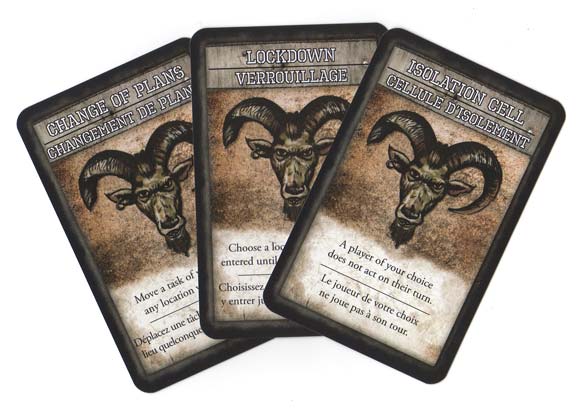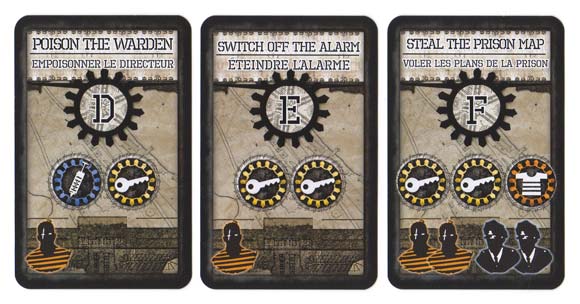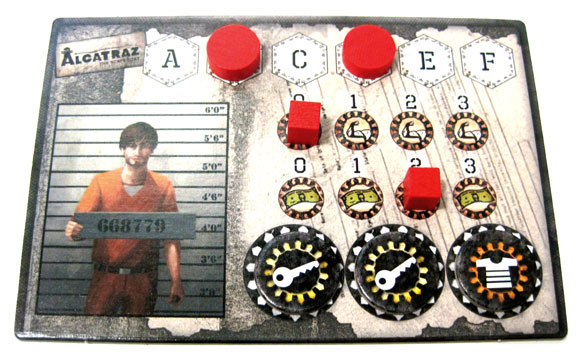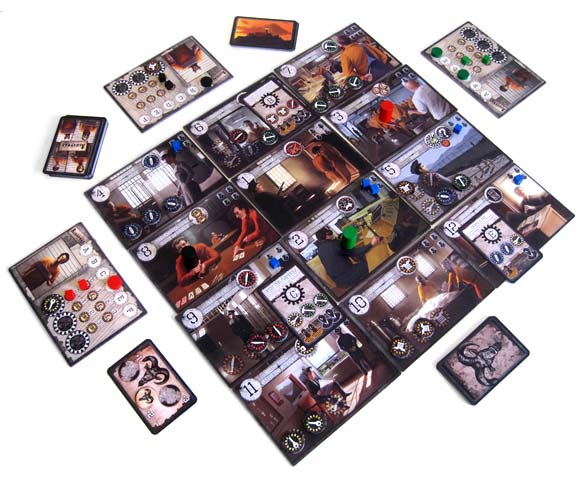
Alcatraz: The Scapegoat
Overview
Alcatraz: The Scapegoat is a semi-cooperative game where players, as inmates of that most infamous prison, must accomplish together six stages of an escape plan. Some tasks can be accomplished alone. Other tasks rely upon the cooperation of fellow prisoners. Loose alliances are formed and then quickly broken. The escape occurs when the 6-stage plan is complete at which point, the inmates that are indispensible to the plan will escape to freedom. One inmate however, will be left behind.
Setup
Alcatraz takes place on a modular board that represents 12 areas of the prison. The tiles are set up in a 3×4 grid and each contains a place to track the Guards that are present in that area (up to four) and the items prisoners need to execute their escape plan. The five different items (Drugs, Shirts, Knives, Keys, Tools,) represented by small disks, are keyed to that area. For example: Drugs can be found in the infirmary, Tools in the Workshop and so forth.
Players receive a player board that tracks the items they have acquired to accomplish tasks, the actual tasks they have accomplished as well as Fortitude and Cash: very useful when trying to escape an un-escapable prison.
Player tokens are randomly placed in different areas of the prison, and three tasks, represented by Task cards identified by a letter from A to F, are also placed in three random areas. The Task cards, Location cards and Blackmail card decks are shuffled and placed nearby.
One player is randomly chosen as the Scapegoat for the first round. What this means will be explored later. Once the game is set up, let the plotting, planning and scheming begin.
Gameplay
Gameplay for Alcatraz: The Scapegoat has 3 major Phases that constitute one Round.
Place a new Guard.
One location card is drawn and one Guard (blue cube) is placed in the corresponding area. An area can only hold a maximum of four Guards.
Guards are a key element to the game in several ways; the most important of which is that all players lose the game and stay in prison when the 21st blue Guard cube is placed in the prison. Guards can also interfere with completing tasks. Too many Guards in an area and players will not even be able to enter that area.

Elect a Scapegoat.
Being the Scapegoat has its advantages and disadvantages. The game uses action points when executing the escape plan. The Scapegoat always gets at least one additional Action point to use. If a player is elected Scapegoat on subsequent turns, they receive additional Action points. The Scapegoat is also the only player that may play the usually devastating (and often times game changing) Blackmail cards. The big downside in being the Scapegoat is that player cannot get credit for completing parts of the escape plan, which of course is the object of the game.
Execute the Escape Plan.
Each Player receives two Action points (three in a 3-player game) to further their goal for escape. Action points allow an inmate to move to an adjacent area, pick up an object necessary for the tasks from a location, steal an object from another player, move Guards between areas, and most importantly, advance the escape plan by satisfying the terms on the Task card. Each Task has requirements and parameters by which they are accomplished. Using one of the Task cards pictured below (“Steal the Prison Map”) at least two inmates would need to be present in this location with two Keys and one Clothes between them and no more than two Guards can be present in the area.

If all the conditions are met the player who’s spends the action point to complete the task places a token on the “F” space on their play board (using the example Task above) then draws another Task card awarding that new letter to the other player who is NOT the Scapegoat. In effect, two parts of the escape plan can be completed when one Task is accomplished, but only for the inmates that are not the Scapegoat.
As soon as all six letters (A-F) of the plan are acquired by any combination of the players, the game ends and all but one of the inmates will make their escape – creating the unique game-end experience of all players winning but one.
Ultimately, each player’s goal is to travel around the prison and complete tasks and acquire parts of the escape plan that the other players do not have – making oneself indispensible to the escape. This is where the heart of the game and the rivalries begin.
Components
The art and components are well made, and functional. The rules are reasonably easy to follow. An image of the completed game setup would have helped to make game set up easier, but once learned it isn’t complicated. Quality wooden components and thick cardboard boards and tokens make the feel of the game substantial.

Learning Curve
Alcatraz: The Scapegoat has a moderate learning curve in that, the actual game mechanics are quite straightforward. What’s not so straightforward is negotiating the social aspects of the game. This sort of interaction may come naturally to some, but may be more difficult for others.
Who would enjoy this game?
Final Thoughts
Since the advent of the cooperative game, most designers have been working from a basic blueprint: all players work together to defeat the game together.The game itself being a programmed series of events, either random or by incrementally increasing challenges that require the players to plan together to meet these challenges and succeed together or suffer the consequences of failure; usually mutual defeat. Sometimes however, co-op games may create an environment where dominant personalities may assert themselves – providing a social imbalance and a less than gratifying game.
Alcatraz: The Scapegoat on the other hand, keys in on the different personality traits of the players and exploits them. It expertly creates a balanced atmosphere of mutual need (to escape!) with each player’s individual fear of being left behind (losing). This fear drives a player to play in one of two modes. The first: looking out for “number one.” Creating an individual strategy, using Action points to further their own advancement toward completing tasks believing this will give them an advantage in being indispensible to the escape. However, no actions are taken without them somehow affecting the other players. So it soon becomes necessary for players to work together to accomplish certain tasks. Then the second mode of play takes shape: alliances. Trading with other players or working together immediately excludes and ostracizes other inmates, providing a tension and emotional reaction that, more than likely, elicits a response. The tension created by this aspect of the game is gritty and nerve-racking. It culminates when the players vote on a Scapegoat for the round.
This is the key feature of the game that differentiates it from other co-op games. Who should be the Scapegoat? The player who betrayed you last round? The player that has no tasks completed, or the player who has the most? Or should you vote for yourself to provide the advantage offered by the Blackmail cards and more action points in order to throw a monkey wrench into the other inmates’ schemes?
Designers Rafał Cywicki, Krzysztof Cywicki and Krzysztof Hanusz masterfully create a themed environment where your actions as a player weigh heavily on whether or not you become indispensible – insuring victory. Step too far out of line against the other players and you will more than likely be elected Scapegoat. Too docile approach and you may not become the indispensible player needed for the escape. This plunges players into a tension filled environment of half-truths and blind faith: the very darkest side of human behaviour. Perfect for a setting like Alcatraz.
At its core, the game employs action point allowance system and task completion to create the victory conditions. But beyond the rules and basic strategies a personal interaction is created – like a Petri dish of human emotions – that creates a different game experience and social experiment with every new game and new group of players.
To be able to entertain and excite players with a new game design is impressive. To manipulate emotions, create tension and provide amazing replay value and entertain at the same time, is genius. For a mature and gratifying experience, play Alcatraz: The Scapegoat again and again.
Play with friends and you may need their forgiveness afterward.
User Reviews (2)
Add a Review for "Alcatraz: The Scapegoat"
You must be logged in to add a review.



Alcatraz is a game that is cooperative yet competitive, static and changing. It is quite a lot of fun! The game board consists of twelve tiles that can be arranged in any order, in a 3 by 4 grid. These are rooms in the prison, that can provide various tools or other actions that are useful in the game. You and your friends are trying to escape Alcatraz, and in order to do that, you must complete tasks, with letters on them, A through F. Once each task is represented by all players, you can escape…BUT one of you must stay behind! So as opposed to a game with one winner and several losers, this is a game with several winners and one loser. This sets up an individual, frequently the Scapegoat, to possibly hinder escape. Each round, players vote on a Scapegoat, who receives an extra action in his or her turn, and they cannot receive credit for tasks completed that turn! To determine the loser, you look to see which player is the least useful in your escape…meaning you are the least redundant when it comes to tasks completed. For example, if only one player has completed task E, that player will be with the winners, because without her, the team cannot escape. Another player has completed tasks B, D, and F, but those are all tasks that others have completed also. This player is at risk of being left behind.
The game mechanic is very simple, and the game gets quite tense. I highly recommend it!
Cooperative game for 3 or 4 players. I’ve an opportunity to try it before premiere and express my opinion. There’s many solutions, not so often to recognize to other games – most striking is that only one person loose (this game won’t be right for people, who don’t like negative interaction) and players in fact can decide, who will loose. Player’s claim is gain as many as possible unique letters form making quest (direct) and commons from help during quest. There’s nothing strange in situations, that you’re blocked by other player, because he doesn’t want to let you gain a unique letter (ofc he want to gain it). It may provide problems, especially that this game requires cooperation. In addition every character (drawn at the beginig) has his own special ability, what may be useful during making quests, or thwart other players.
Element, what push forward the game, is making quests in random locations – we need to have special items to do it (other for every quest, we can find them in individual locations). Almost never we’re able to do it alone. Sometimes we need to agree for some compromise, but we musn’t forget about build our possistion – we need to be always in the centre of action, because when other players decide, that we’re most useless, in the next vote we’ll become a Scapegoat (player who not get any letter in direct turn). Sometimes – it can be usefull to prepare for do quest in next turn (extra action), but we must be sure, that in this turn other players are not able to do any quest. The worst (for both sides), is stuck in goat’s role and stay behind other players. Then – that player becomes a real impediment, but can’t do anything by himself.
I think, that is it worth to play. As I said – game use many innovations, and that could be nice variety for bored gamers 😉